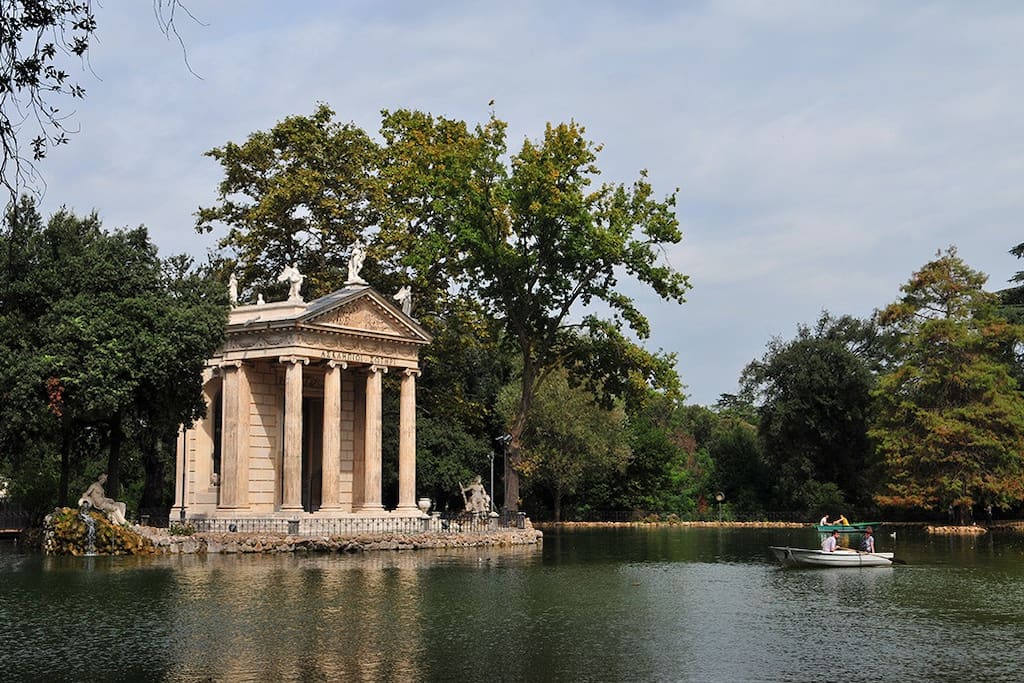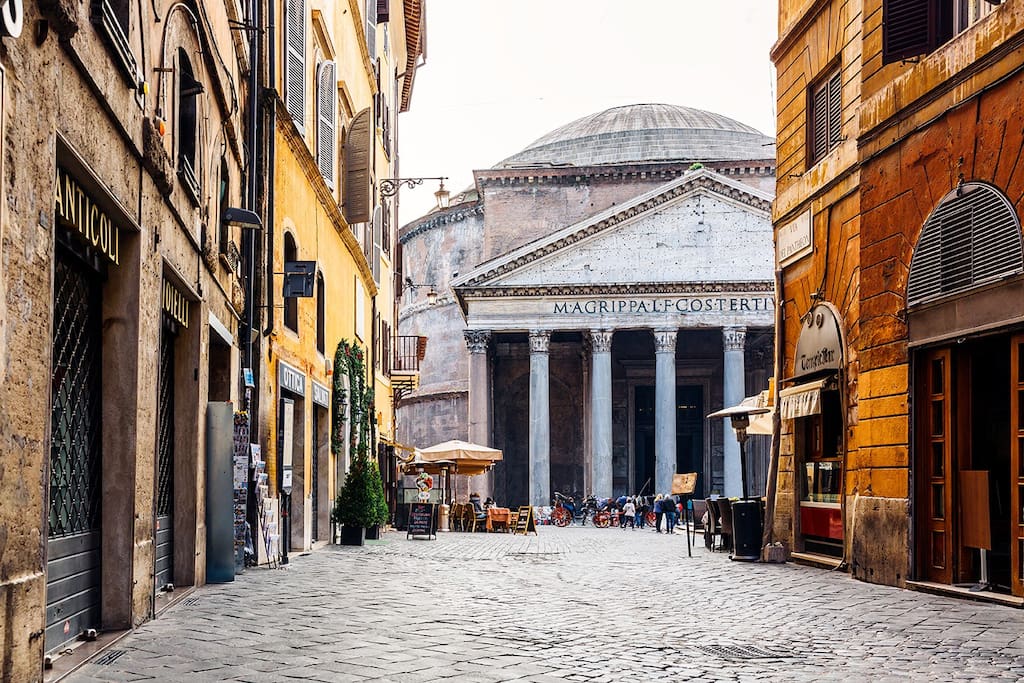Parks & Nature
Pincio Promenade
Viale Gabriele D'AnnunzioVialla Borghese, with the tree-lined street, lawns, statues and fountains, is the largest public park in Rome, and was founded in the seventeenth century by the powerful Cardinal Scipione Caffarelli Borghese, nephew of Paul V. The area of the park, bordering the elegant Parioli and Ludovisi districts, includeds three major museums (Galleria Borghese, Galleria Nazionale d'Arte Moderna and the Museo Etrusco di Villa Giulia), in addition to the Miseo Pietro Canonica, the new Museo Carlo Bilotti, the "Casa del Cinema", and the Zoological Garden (Zoo), re-cently restored. The best roof terrace in Rome, the famous Belvedere Picio overlooking Piazza del Popolo, is part of the Villa.
2099 lokalinvånare rekommenderar
Villa Borghese
Piazzale Napoleone IVialla Borghese, with the tree-lined street, lawns, statues and fountains, is the largest public park in Rome, and was founded in the seventeenth century by the powerful Cardinal Scipione Caffarelli Borghese, nephew of Paul V. The area of the park, bordering the elegant Parioli and Ludovisi districts, includeds three major museums (Galleria Borghese, Galleria Nazionale d'Arte Moderna and the Museo Etrusco di Villa Giulia), in addition to the Miseo Pietro Canonica, the new Museo Carlo Bilotti, the "Casa del Cinema", and the Zoological Garden (Zoo), re-cently restored. The best roof terrace in Rome, the famous Belvedere Picio overlooking Piazza del Popolo, is part of the Villa.
Sightseeing
best view of Rome...at sunset is the best time
The square is dominated by the imposing and much-debated Monument to Vittorio Emanuele II also know as Altar of the Fatherland, build between 1884 and 1927, and called "the typewriter" by the Romans for itssquare shape. Next to the older and much steeper stairs leading to the medieval Church of Santa Maria in Aracoeli, Michelangelo devised a monumental wide ramped stair, gradually ascending the hill to reach the high Piazza del Campidoglio, designed in 1530.
576 lokalinvånare rekommenderar
Piazza Venezia
The square is dominated by the imposing and much-debated Monument to Vittorio Emanuele II also know as Altar of the Fatherland, build between 1884 and 1927, and called "the typewriter" by the Romans for itssquare shape. Next to the older and much steeper stairs leading to the medieval Church of Santa Maria in Aracoeli, Michelangelo devised a monumental wide ramped stair, gradually ascending the hill to reach the high Piazza del Campidoglio, designed in 1530.
Piazza Navona, which follows the size and shape of the old "Stadium of Domitian". Pope Innocent X decided to embellish the area in honour of his family, the Pamphilj; various kinds of performances, celebrations, and even naval battles were organized in the square until the 19th century. The splendid area is dominated by the ''The Fontana del Nettuno or Calderari and the Fontana del Moro'' at either end of the square, and by the central "Fountain of the Four Rivers", designed by Bernini between 1648 an 1651. Opposite the Bernini's masterpiece, on the ruins of an ancient basilica, stands the Church of San'Agnese in Agone in Greek cross plan, completed in 1652 by Borromini.
1722 lokalinvånare rekommenderar
Piazza Navona
Piazza Navona Piazza Navona, which follows the size and shape of the old "Stadium of Domitian". Pope Innocent X decided to embellish the area in honour of his family, the Pamphilj; various kinds of performances, celebrations, and even naval battles were organized in the square until the 19th century. The splendid area is dominated by the ''The Fontana del Nettuno or Calderari and the Fontana del Moro'' at either end of the square, and by the central "Fountain of the Four Rivers", designed by Bernini between 1648 an 1651. Opposite the Bernini's masterpiece, on the ruins of an ancient basilica, stands the Church of San'Agnese in Agone in Greek cross plan, completed in 1652 by Borromini.
Campo de' Fiori in the 16th century became the site of executions and punishments with stretches od rope. In 1600 the philosopher Giordano Bruno, accused of heresy, was burned alive here. In memory of the philosopher, 1888 a bronze monument was set. Campo de' Fiori is the only historic square in Rome without a church. The lively square is currently characterized by pubs, restaurants and the famous market held every morning.
787 lokalinvånare rekommenderar
Campo de' Fiori
Campo de' FioriCampo de' Fiori in the 16th century became the site of executions and punishments with stretches od rope. In 1600 the philosopher Giordano Bruno, accused of heresy, was burned alive here. In memory of the philosopher, 1888 a bronze monument was set. Campo de' Fiori is the only historic square in Rome without a church. The lively square is currently characterized by pubs, restaurants and the famous market held every morning.
Portico D'Ottavia, built by Augustus to honour his sister, and transformed into a medieval fish market and after in the church of Sant'Angelo in Pescheria, and Via di Santa Maria del Pianto. Crossing Via Arenula, we arrive at Via dei Giubbonari, then at Via dei Balestrari and at Piazza Farnese, which is dominated by the homonymous palace, one of the finest examples of Renaissance architecture.
111 lokalinvånare rekommenderar
Portikus av Octavia
29 Via del Portico d'OttaviaPortico D'Ottavia, built by Augustus to honour his sister, and transformed into a medieval fish market and after in the church of Sant'Angelo in Pescheria, and Via di Santa Maria del Pianto. Crossing Via Arenula, we arrive at Via dei Giubbonari, then at Via dei Balestrari and at Piazza Farnese, which is dominated by the homonymous palace, one of the finest examples of Renaissance architecture.
Piazza di Spagna has always been the center of cultural and touristic city with many artists who used to spend their days here. In the middle of the suare you can admire the Barcaccia Fountain, a work commissioned by Pope Urban VIII to the artist Pietro Bernini. The fountain recalls the historic flood of 1598, with allowed the 'barcacce', typical river boats to transport goods from the Tiber, to reach the point where today stands the fountain. The square is dominated by the majestic Staircase of Trinita' dei Monti, built in the 18th century to link the area to the homonymous church above.
1307 lokalinvånare rekommenderar
Piazza di Spagna
Piazza di SpagnaPiazza di Spagna has always been the center of cultural and touristic city with many artists who used to spend their days here. In the middle of the suare you can admire the Barcaccia Fountain, a work commissioned by Pope Urban VIII to the artist Pietro Bernini. The fountain recalls the historic flood of 1598, with allowed the 'barcacce', typical river boats to transport goods from the Tiber, to reach the point where today stands the fountain. The square is dominated by the majestic Staircase of Trinita' dei Monti, built in the 18th century to link the area to the homonymous church above.
Piazza del Popolo, placed at the apex of the famous triangle of roads, the 'Tridente', is a great access to the heart of Rome. The square, one of the most beautiful in Rome, has gradually formed throughout the centuries: in 1589 Pope Sixtus V erected the ancient Egyptian obelisk that stands in the centre, and almost a century later the two 'twin churches' of Santa Maria dei Miracoli and Santa Maria in Montesanto were built. In the 19th century the square took on the grand oval thanks to the work of Giuseppe Valladier, the favourite architect of Napoleon and the master of the gardens of Pincio.
797 lokalinvånare rekommenderar
Piazza del Popolo
Piazza del PopoloPiazza del Popolo, placed at the apex of the famous triangle of roads, the 'Tridente', is a great access to the heart of Rome. The square, one of the most beautiful in Rome, has gradually formed throughout the centuries: in 1589 Pope Sixtus V erected the ancient Egyptian obelisk that stands in the centre, and almost a century later the two 'twin churches' of Santa Maria dei Miracoli and Santa Maria in Montesanto were built. In the 19th century the square took on the grand oval thanks to the work of Giuseppe Valladier, the favourite architect of Napoleon and the master of the gardens of Pincio.
Via Veneto, the elegant avenue, designed around 1889, is famous mainly for being the privileged stage of social life of the '50s and '60s of the twentieth century, thanks to the many cafes and hotels frequented by celebrities in the period of the "Dolce Vita".
171 lokalinvånare rekommenderar
Via Veneto
Via Vittorio VenetoVia Veneto, the elegant avenue, designed around 1889, is famous mainly for being the privileged stage of social life of the '50s and '60s of the twentieth century, thanks to the many cafes and hotels frequented by celebrities in the period of the "Dolce Vita".
Colosseum
1 Piazza del ColosseoFori Imperiali
Pantheon
Piazza della RotondaBocca Della Verita' station
Circo Massimo station
Parco del Gianicolo
Piazzale Giuseppe GaribaldiSan Pietro in Vincoli
4/a Piazza di San Pietro in Vincolinot tourist but amazing church
Palatine Hill
Via SacraSan Pietro
Vatikanmuseerna
Shopping
Via del Corso
Via del CorsoThe elegant Via del Babuino (Baboon Street) connects Piazza del Popolo with Spanish Steps; the origin of its name is curious: in 1571 a fountain adorned with a statue of a Silenus was built, but the people did not like it and likened its features to a baboon.
14 lokalinvånare rekommenderar
Via del Babuino
Via del BabuinoThe elegant Via del Babuino (Baboon Street) connects Piazza del Popolo with Spanish Steps; the origin of its name is curious: in 1571 a fountain adorned with a statue of a Silenus was built, but the people did not like it and likened its features to a baboon.
Via dei Giubbonari
Via dei GiubbonariRione Monti
vintage shops and hand-crafted production
Drinks & Nightlife
Trastevere
pubs...perfect if you like beer and cocktail
Rione Monti
wine bars...and romantic location!!!
Campo de' Fiori
Campo de' FioriFood Scene
Great roman food, especially the pasta dishes ( Carbonara, lasagna, etc. ), are delicious...friendly waiters and relaxing atmosphere. Situated in the charming neighbourhood of Trastevere. NOT expencive restaurant (lunch and dinner).
16 lokalinvånare rekommenderar
Trattoria Otello Trastevere
47/53 Via della PellicciaGreat roman food, especially the pasta dishes ( Carbonara, lasagna, etc. ), are delicious...friendly waiters and relaxing atmosphere. Situated in the charming neighbourhood of Trastevere. NOT expencive restaurant (lunch and dinner).
The place is closed to Trilussa square. This restaurant offers excellent value for money - and as foodies, it is excellent value too. Best Pizza in Rome.
217 lokalinvånare rekommenderar
Dar Poeta
45 Vicolo del BolognaThe place is closed to Trilussa square. This restaurant offers excellent value for money - and as foodies, it is excellent value too. Best Pizza in Rome.
Close to Piazza Navona. Staff is super friendly and welcoming. Very good typical Italian pastas, pizzas and main courses. Free Wi-Fi.
14 lokalinvånare rekommenderar
433
123 Via del Governo VecchioClose to Piazza Navona. Staff is super friendly and welcoming. Very good typical Italian pastas, pizzas and main courses. Free Wi-Fi.
Tonnarello
1/2/3 Via della PagliaOfferta gastronomica
good food, not expensive...perfect for a fast lunch or dinner ;)
31 lokalinvånare rekommenderar
Prosciutteria Trastevere - Cantina dei Papi
71 Via della Scalagood food, not expensive...perfect for a fast lunch or dinner ;)
Antico Forno Roscioli
34 Via dei ChiavariImpiccetta
7 Via dei Fienaroli



